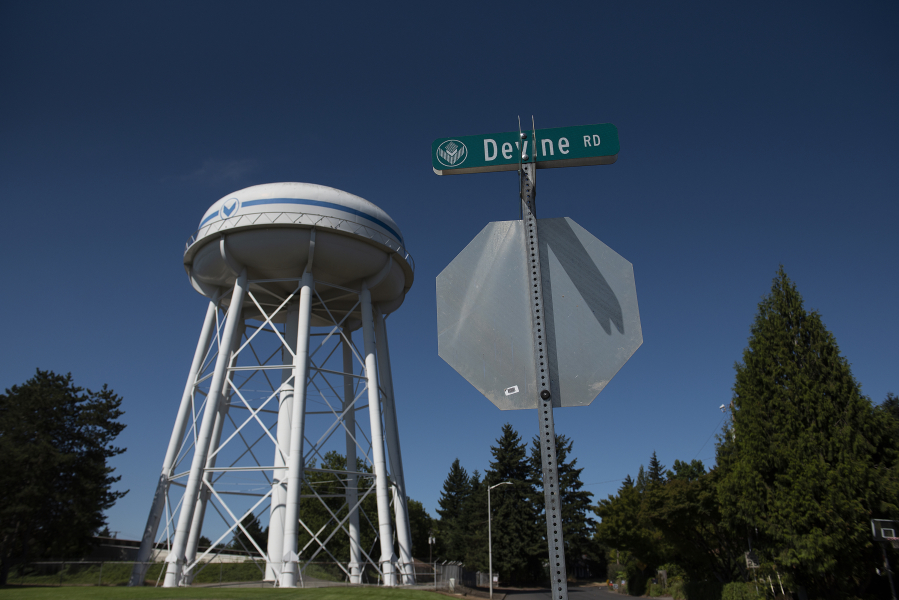The city of Vancouver has found that three of its nine well fields exceed state levels for “per- and polyfluoroalkyl substances,” compounds harmful to both humans and the environment in testing in late February.
The substances, also known as PFAS, include thousands of human-made compounds that have been branded “forever chemicals,” since they don’t break down in soil, water or the human body, said Tyler Clary, Vancouver water engineering program manager.
Later this week, Vancouver public water customers will receive a mailer outlining water sampling results, as well as the city’s next steps to address the issue.
Washington’s drinking water levels, adopted in 2021, regulate five types of PFAS and provide guidance for how much water a user can consume over a lifetime and not suffer adverse health effects, even in sensitive groups.
Vancouver’s findings indicate the most common compounds found at Water Stations 4, 14 and 15 — the well fields under focus — were perfluorooctanoic acid, or PFOA, and perfluorooctane sulfonic acid, or PFOS.
These are two of five state-regulated compounds, which have been removed from most products due to health and environmental risks, according to the Environmental Protection Agency. They have also been produced in the largest quantities within the United States.
Altogether, Vancouver’s findings don’t reveal much new information. In 2020, Vancouver found several of its water stations had contaminants, and later sampling revealed 36 of Vancouver’s 40 wells contained some level of PFAS. Since then, officials have taken steps to create a PFAS management plan and apply for grants.
The state awarded Vancouver nearly $12.7 million this year to install a treatment system at Water Station 14, which has the highest concentration of PFAS. The city is currently pilot testing treatment methods to determine what the best option will be.
Consultants for the city estimate it would cost $172 million to install treatment systems for all Vancouver’s wells that exceed state action levels.
But this number could easily skyrocket.
In March, the EPA proposed a federal drinking water limit for both PFOA and PFOS, which is lower than Washington’s current action levels. If passed, Vancouver would be required to install treatment systems at eight of its nine well fields — raising capital costs from $172 million to upwards of $280 million to 300 million, Clary said.
City and county officials urge residents to educate themselves on PFAS before jumping to conclusions. For more general information, visit www.cityofvancouver.us/publicworks/page/learn-about-pfas and www.clark.wa.gov/public-health/pfas-drinking-water.
Vancouver’s public water system serves roughly 78,000 customers. To check your public water source, visit Clark County’s online property information center.
‘What can I do?’
It’s tricky, perhaps even impossible, to escape PFAS.
“The vast majority of us have PFAS (in our bodies) if we’re living in the world,” Clark County Public Health Officer Dr. Alan Melnick said.
The chemicals are found in everyday items that are resistant to heat, water, stains and oil, because that’s what they were designed to do. Producers incorporated them into items since the 1940s, such as nonstick pans, food wrappers, outdoor gear, cleaning items and cosmetics.
According to the Centers for Disease Control and Prevention, PFAS levels in today’s goods are lower than those in contaminated drinking water.
But don’t rush to get screened for the chemicals right away.
Exposure to PFAS doesn’t necessitate additional health screening, as it’s likely they already exist within us and the mechanisms of how these chemicals influence our bodies is largely unknown, Melnick said.
Conditions that have been associated with exposure include elevated cholesterol levels and blood pressure, impaired immunity and increased risks of thyroid disease and testicular and kidney cancer.
Still, it’s largely unknown how PFAS affect animals and humans.
“If you have that condition and you have PFAS in your body, it doesn’t mean it was caused by PFAS,” he said. “There are many other things that are likely to cause these conditions, as well.”
Melnick recommends adopting or continuing healthy practices to sustain one’s well-being. There is nothing individuals need to do differently to protect their health, but they can reduce their potential exposure to PFAS.
Water filters can be installed where tap water is retrieved for drinking or cooking, whether it’s from a refrigerator or kitchen sink. These devices traditionally use reverse osmosis, which is when water passes through a synthetic lining, or granular activated carbon, when carbon absorbs chemicals dissolved in water.
Each comes with its own strengths and weaknesses related to cost or efficiency.
A list of filters certified for PFAS removal can be found on the Washington Department of Health website. These are filters that reduce PFOS and PFOA concentrations of 1,500 parts per trillion to less than 70 parts per trillion over the lifespan of the device. To compare, state action levels set water limits of 15 parts per trillion for PFOS and 10 parts per trillion for PFOA.
Bottled water can be an alternative to tap, but it isn’t a guaranteed solution. Consumer Reports found in 2020 that some bottled water products, both still and carbonated, contained PFAS that exceeded voluntary PFAS levels established by the Food and Drug Administration. Municipal tap water is regulated by the EPA and individual states, which may be stricter than federal standards.




